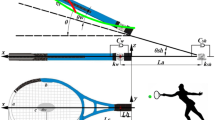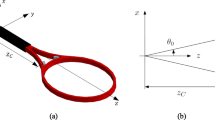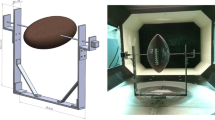Abstract
Measurements and calculations are presented on the vibration of the handle of a tennis racquet. It is shown that the vibration amplitude depends primarily on the stiffness of the racquet, but it also depends on the mass of the racquet, the mass distribution, the vibration frequency, the impact location, the impact duration, the stiffness of the ball and the stiffness of the string plane. Mass added at the tip of a racquet usually reduces handle vibrations when the ball impacts near the tip, but it increases handle vibrations for impacts in the throat region. Mass added to the handle usually reduces handle vibrations, regardless of the impact point. Mass added at a vibration node point has no effect on the vibration frequency, only a small effect on amplitude, and can usefully be added to very light and stiff racquets to increase racquet power without affecting the low vibration amplitude of these racquets. The amplitude of the fundamental vibration mode decreases as the impact duration increases, decreasing to zero at all impact points when the impact duration is 1.5 times longer that the fundamental vibration period.












Similar content being viewed by others
References
Kotze J, Lammer H, Cottey R, Zirngibl W (2003) The effects of active piezo fiber rackets on tennis elbow. In: Miller S (ed) Tennis science and technology, 2nd edn. ITF, London, pp 55–60
Brody H (1989) Vibration damping of tennis rackets. J Sports Biomech 5:293–296
Brody H, Cross R, Lindsey C (2002) The physics and technology of tennis. Racquet Tech Publishing, Solana Beach
Li F-X, Fewtrell D, Jenkins M (2004) String vibration dampers do not reduce racket frame vibration transfer to the forearm. J Sports Sc 22:1041–1052
Cross R (2001) Customising a tennis racket by adding weights. Sports Eng. 4:1–14
Cross R (1999) Dynamic properties of tennis balls. Sports Eng. 2:22–23
Cross R (1999) Impact of a ball with a bat or racket. Am J Phys 67(8):692–702
Cross R (2000) Flexible beam analysis of the effects of string tension and frame stiffness on racket performance. Sports Eng 3:111–122
Goodwill S, Haake S (2003) Modelling of an impact between a tennis ball and racket. Tennis science and technology 2. International Tennis Federation, London, pp 79–86
Nathan A (2000) Dynamics of the baseball bat collision. Am J Phys 68(11):979–990
Reynolds D, Standlee K, Angevine E (1977) Hand-arm vibration. Part III, Subjective response characteristics of individuals to hand-induced vibration, Journal of Sound and Vibration 51(2):267–282
Cross R, Nathan A (2009) Performance versus moment of inertia of sporting implements. Sports Technol 2(1–2):7–15
Author information
Authors and Affiliations
Corresponding author
Appendices
Appendix A: Fourier transform of half-sine waveform
Any function \(v(t)\) that is symmetrical about \(t = 0\) can be expressed in the form \(v(t) = \int _{0} ^{ \infty } a(\omega ) \cos (\omega t)\, \mathrm{d}\omega \) where \(a(\omega ) = (1/\pi ) \int _{-\infty } ^{ \infty } v(t) \cos (\omega t) \, \mathrm{d}t\) is the Fourier transform of \(v(t)\). A symmetric half-cos function is \(v(t) = v_{0} \cos (\omega _{0} t)\) when \(-\tau _{0} < t < \tau _{0}\) and \(v(t) = 0\) when \(t < -\tau _{0}\) or \(t > \tau _{0}\) where \(\tau _{0} = \pi /(2\omega _{0})\). The Fourier transform of this function is
which is easily integrated to give
The duration of \(v(t)\) is \(\tau = 2\tau _{0}\). \(a(\omega )\) is not zero when \(\omega \tau _{0} = \pi /2\) since then \(\omega _{0} = \omega \). The first zero of \(a(\omega )\) is at \(\omega \tau _{0} = 1.5 \pi \) and then \(f = \omega / (2\pi ) = 1.5/\tau \). Typical results relevant to racquets are shown in Fig. 13.
Appendix B: Three-element beam model
Consider a rectangular beam of mass \(M\) and length \(L\) constructed from three uniform sections each of length \(L/3\) and with masses \(m_{1}\), \(m_{2}\) and \(m_{3}\). The total mass is \(M = m_{1}+m_{2}+m_{3}\) and the balance point is located at distance \(B = (m_{1} + 3m_{2} + 5m_{3})L/(6M)\) from the \(m_{1}\) end. The moment of inertia about the \(m_{1}\) end is \(I = (m_{1} + 7m_{2} + 19m_{3})L^{2}/27\). Measurements of \(M\), \(B\) and \(I\) can therefore be used to determine \(m_{1}\), \(m_{2}\) and \(m_{3}\).
Rights and permissions
About this article
Cite this article
Cross, R. Factors affecting the vibration of tennis racquets. Sports Eng 18, 135–147 (2015). https://doi.org/10.1007/s12283-015-0173-7
Published:
Issue Date:
DOI: https://doi.org/10.1007/s12283-015-0173-7





